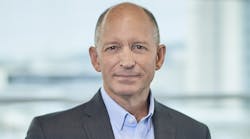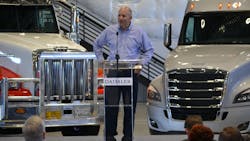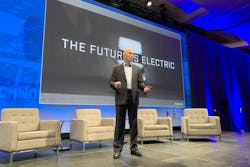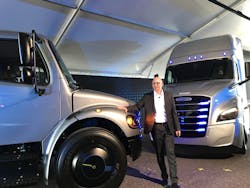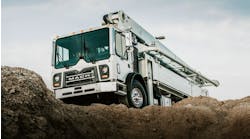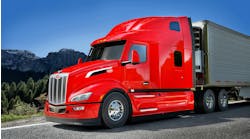Emissions regulations handcuffed truck manufacturers 15 years ago, and the transition was painful for OEMs and fleet customers alike. The industry now is facing a revolutionary change with electrification as the new frontier. But for outgoing Daimler Trucks North America (DTNA) CEO Roger Nielsen, the focus has always been about the customer.
Ask Nielsen about his 35-year tenure at DTNA, and he’ll tell you he’s halfway through and ready for the next 35 years.
Nielsen, who will officially retire on April 30, started out at Freightliner when he was 25 years old. A Portland, Ore., native, after Nielsen graduated from college with a degree in engineering and was working in California, he took the chance on an opportunity to come back home.
“When I started 35 years ago, it was a great chance with Freightliner to move back to my hometown in Portland,” Nielsen said. “I often tell the story that I only took the offer because they were going to pay for my relocation—like $900 or something for the 24 boxes I owned at the time. I said, ‘OK I’ll stay 12 months, so I don’t have to pay it back.’”
Twelve months turned into three-and-a-half decades for Nielsen, who began his career in 1986 as a Freightliner manufacturing engineer. He later moved on to management positions in manufacturing and supply chain management before he was chief operating officer from 2001 to 2016.
Since 2017, Nielsen served as the president and CEO of DTNA. Under his leadership, he started several customer trials with the Freightliner eCascadia and eM2, and launched the Thomas Built Buses Jouley school bus to pave the way for CO2-neutral transport at DTNA. In addition, he renewed the Western Star product lineup and the vocational truck business.
On Feb. 16, Daimler Truck AG announced Nielsen’s retirement and that effective April 1, John O’Leary would succeed him as DTNA’s next president and CEO.
“It’s been a great experience for me,” Nielsen said. “Back in 1986, our market share was 13%. It was a terrible time in the marketplace. I had been in the company for about two months before they shut everything down for about two weeks because of the lack of orders.
“I had no vacation, so I sat in the dark office for two weeks and taught myself everything I needed to know about data systems and things like that at Freightliner,” he continued.
The company eventually entered a major growth period, opening the Cleveland Truck Manufacturing Plant in North Carolina in 1989. Two years later, DTNA expanded into the medium-duty business. As COO in 2001, Nielsen met and began working with O’Leary while the team was coordinating the transformation of the company.
We focused on customers, focused on variable costs, and focused on growth,” Nielsen explained. “Since that time, it’s been onwards and upwards all the way through 2020. And the past year with COVID still brought us to the top of our game and still allowed us to claim that we were this industry’s leader. We have a great team behind us, and it’s great to be able to leave while the company is doing well.”
Nielsen expressed his excitement for the future of the company, which is expanding its digital vehicle products with recently announced telematics solutions and partnerships and splitting off its truck and bus business.
“As Daimler Truck AG spins off from Daimler, our agility and nimbleness actually increases,” Nielsen explained. “At Daimler Truck AG, we see it as not just looking to our mother company for innovations and inventions, but we’re actually being the best in the marketplace and attracting companies to partner with us to transform this industry.”
Nielsen, who quipped that he wished he was 25 so he could start all over again, sat down with FleetOwner to talk about his 35-year career with DTNA and what challenges and opportunities lie ahead for his successor.
FleetOwner: Let’s talk about 1986 and your perspectives on the evolution of the industry from then until now. How were you able to leverage the experience from your days as an engineer in your later management positions and leadership roles?
Roger Nielsen: I started as a manufacturing engineer. I found that type of job brings you such a breadth of interactions across the company. You’re working on vehicle launches, you’re working with the people on the shop floor, you’re working with the engineers, and you learn everything about how a truck works. You learn how to build it and what it takes to build it efficiently; you learn all about costs. With that, I was given so many opportunities to work on startups and things like that. For example, the Cleveland truck plant started its life as a city bus factory for MAN. I was allowed to go in there on our first inquiry to decide whether or not we wanted to buy that factory.
I was given so many chances through the ̍90s to look at ambulance and fire truck companies and to look at income statements and balance sheets. As an engineer, I had no idea what they were, but rubbing elbows with folks like John O’Leary, I got some business acumen that you otherwise cannot pick up at a university. I was given so many opportunities as a younger employee in the company that as we operate today, I always think back and look at how we can give those same opportunities to the folks that are coming up in the company now.
FO: The last 15 or 20 years have seen major changes in trucks and technology: EGR-SCR issues, powertrain integration, AMTs [automated manual transmissions], telematics, GHG-aero, autonomy, and electrification. What were the biggest hurdles?
RN: I would say our biggest hurdle has been complying with diesel exhaust emissions standards. We were laser-focused on getting through 2004 and introduced EGR [exhaust gas recirculation]. Then we took the bold move along with others to introduce SCR [selective catalytic reduction] in 2010. Going through that transition was full of risk, but it was the right move as we all see.
The second is the effort we put into creating a dealership network. We had dealers across the country, so if you bought one of our trucks, you could go anywhere in the Freightliner or Western Star network and get the truck serviced — be it the engine, the transmission, or the whole vehicle — and the dealers cooperate and take pride in the fact that they are a network that relies on each other.
Between us getting great products to the marketplace and our dealers putting in the capacity and the processes to support us, those two pieces of the pie needed to be done because great products weren’t going to get us there. We needed the support and network in the field and the dealer network to be able to accomplish what we did.
FO: You’ve really made a customer-experience push. How have customer expectations changed? Are they demanding more than they had before? Internally, what is involved in this customer-experience focus?
RN: The impetus is I got my butt kicked by one of our major customers. It came down to the customer saying, “You’ve got great products, they meet my needs, but you’re not so easy to do business with, and because you’re not so easy to do business with, you’re not fun to do business with.”
If you’re not fun to do business with, it’s hard to create a relationship, which creates loyalty. So, we started with that focus: How can we become that company where whenever a customer calls, whoever they choose to call, that person takes responsibility for that customer’s issue, and not only takes responsibility for it but assumes the same urgency as the customer has for that issue?
We didn’t necessarily have that. We were very siloed. If you were in electrical engineering and it was a field service problem, they would get you the number for the field service guy. One customer told us that it took an average of six phone calls within our company to get one problem solved, and we said, “This can’t be.”
We put our company through an indoctrination in training—and we are still investing in it—to create a customer experience. That attitude shift and cultural shift has been amazing inside the company.
I’ll give you an example. We had a customer so mad about his truck that he drove it to our corporate office in Portland and came up to the receptionist and explained his problem. He said, “This is a lousy truck.” The receptionist said, “Let me get the right guy for you, and we’ll get this fixed.” Within 24 hours, that guy was driving away in a brand-new truck.
We have no idea what was wrong with his truck, but we didn’t waste his time by putting it in the shop and aggravating him even more. We said, “Let’s get this guy a new truck and get him on the road.” Those kinds of stories and that kind of empowerment of even the front desk receptionist to satisfy a customer’s needs is what we’re looking for.
FO: We've talked about the advancements and progress of technology over the last several decades. I wanted to talk now about the future of vehicle technology. From your perspective, what trends will gain momentum and take precedence?
RN: Technologies will continue to accelerate and you’re going to continue to see the customers demand more frequent changes. We are working with customers now who are expecting that we’ll do a software change every two weeks—when you see a bug, you fix it—like you used to see with iPhones. And that is what a truck is becoming.
We are updating our telematics platform, and we are putting together the basis for other companies to put applications on our telematics. You see that partnership with Platform Science. We’re not getting in the business of creating fleet management software, but we are definitely in the business of creating the operating systems as well as the underlying foundation on the truck, so anything coming off the truck that can be keyed into these data services and be used as they need to.
We are cooperating broader with fleet software services companies to bring their services to the fingertips of the drivers and fleet managers. That’s exciting to see. I think you’ll see the wins there giving a customer a chance to predict when a driver is in trouble or the truck needs maintenance. All that will help the customer and the fleets be more productive, and at the end of the day, have fewer trucks in their inventory parked.
That’s the name of this game. We are talking pennies per mile savings between the difference of whether you’re running red or black numbers.
FO: What are some of the priorities and challenges incoming CEO John O'Leary may face when he takes on your role?
RN: I’ve set him up big for some challenges that we haven’t completely rolled out. Definitely the speed of the demand that is coming at us for zero-emission vehicles—be it battery-electric or hydrogen fuel cell-powered—that speed is ever increasing. We have more battery-electric generations coming out soon, so that’s definitely a challenge to get to the point where the powertrain technology is available to the customers and the customer doesn’t have to make a choice based on incentive grants. The customer makes the choice based on what’s best for the application and total cost of ownership, regardless of what the powertrain may be. The customer doesn’t have to say, “I can’t afford that because it’s too expensive.” That is what we are striving for and hoping for. John definitely has a challenge to bring that to market as fast as possible.
We are facing regulatory action and we see what’s coming down the pike from California and adopted by other states. That’s just the beginning as each municipality and the EPA consider what is the next level of emissions standards. We are prepared for that evolution and emissions standards, which will come with a higher percentage of zero-emission vehicles on the road. Working with the regulatory agencies on that is definitely on the horizon for John, especially with the new administration.
Autonomous also holds a lot of promise to help our customers manage their fleet, reduce their costs, and make better use of this country’s transportation infrastructure by letting trucks run 24-7 autonomously. There are a lot of challenges there, which, again, come on John’s plate. There is a lot of need to work with all those in society—with regulators to the communities—to get the trust that these vehicles are reliable and safe to operate on the highways. That’s going to be a task in front of him as well.
The demand of the market in 2021 and the ability to supply the market with trucks at the demand levels that we are seeing right now is going to be his first head-on challenge when he starts on April 1. From the weather to natural gas shortages to shortages in semiconductors and all those other types of components, and top that with the supply chain disruptions that we’re seeing from different COVID-related incidents, the challenges are there.
We have the best supply chain guys in the world working for DTNA. Every day they pull a rabbit out of their hat, and we get through one more day. But that will definitely be his first front-line challenge—making sure customers’ needs are satisfied this year.
FO: What are your priorities before your departure as president and CEO, and where might we see you next?
RN: I am going to visit 22 states between now and the end of March. I have a habit of showing up as the mystery shopper at the parts counter. If nothing’s broke, I always find a couple five-gallon jugs of DEF [to buy].
In this coming six weeks, what is critical is that we come out of this current crisis we’re in with the weather, which is really throwing everybody for a loop. We need to get back to some sense of normality and addressing this semiconductor shortage. We are working on figuring out what our options are from moving the supply chain faster to finding alternatives. That has really been my focus right now and as John comes on, I hope to make the transition easy for him. But, boy, I’ll just give him my to-do list, and off he goes, and I’ll be smiling.
FO: There are a couple of companies that have never put a working truck on the road that get a lot of headlines. Is that a source of aggravation, motivation, or confusion in the marketplace? What are you hearing from customers?
RN: Everybody announces what their aspirations are, and we always ask ourselves, “Do our aspirations match or exceed that?”
I grew up in Oregon next to a greyhound racing track, and every night those greyhounds chased after that mechanical rabbit and never caught it. They never knew it wasn’t real. That’s how we treat those competitors. We don’t know if it’s real or not, but we’re going to make sure that we’re going to catch them if they’re truly real. So, it’s motivational.
We definitely understand where they are coming from and sometimes we can imagine us saying the same thing as an aspirational message to see what the market does. The specs that are being talked about—from the big walk-in delivery vans that are electric to autonomous driving—are focused on the right things and to the specs and the needs the customers are requesting.
It took us 125 years to get our diesel engine to the top performance it is today. We can’t take 125 years to get electric powertrains to the same performance or autonomous to the same performance level. The pace of innovation is really the challenge. How do we keep pace with what’s going on?
We have a great team, we have great resources across the globe that we draw upon, and we believe we are positioned well to continue to lead this market.
Kevin Jones and Erica Schueller contributed to this report.
